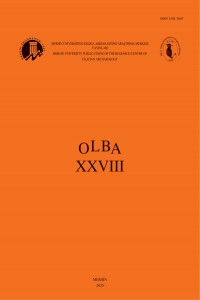Terracotta Figurines from the Temple of Aphrodite at Aphrodisias (Aphrodisias Aphrodite Tapınağı’ndan Ele Geçen Pişmiş Toprak Figürinler)
Öz
The ancient Carian city of Aphrodisias is located in southwestern Turkey, near the modern village of Geyre, in the upper valley of Morsynus River. The city was famous in antiquity for its sanctuary of Aphrodite and its marble sculptors. The first systematic excavations at the site started in 1961 and still continue today. One of the most important structures at the site is the Temple of Aphrodite dedicated to the patron deity of the city. The first phase of the temple is dated to 30 BC, it was enlarged in the 1st century AD and it was then converted into a church in late antiquity. The finds discovered in the excavations of the sanctuary present quite important information about the history of the temple. Amongst the finds, a significant group consists of terracotta figurines. Several areas of the temple were excavated in the 1960’s and during these field works, a total of 32 fragments of figurines were brought to light. The figurines were mostly unearthed in the temenos of the sanctuary. Since the temple had a long and complicated history, the context of the figurines is not very clear. The majority of the figurines represents females. Female types include seated female representations, which were popular in the Archaic Period, fragments of head and drapery reflecting the Tanagra type and various female heads, which were widespread during the Hellenistic and Roman Periods. Furthermore, a relief representing an “Aphrodite-Eros” group has been evaluated within this study. The existence of the “Naked Aphrodite” type is proven through several body and arm fragments. There are two representations of Eros. One is an infant Eros on a relief fragment, the other is a nude youth on an applique fragment of a relief vase. It seems that the male figurines are the least favoured votive offerings to Aphrodite among the figurines from the sanctuary. They are represented with only two examples; the back of a draped kouros figurine and the fragment of head. Another group in this study is the animal representations including dove, bear, ram and cattle, which are all solid and decorated with incisions and lines. All the figurines in this study are votive offerings to Aphrodite and they give information about the cultic activities for the goddess. The scarcity of male figurines is to be expected in the dedication of the votive offerings to deities. Animal representations like dove figurines, are important in terms of indicating the sacred elements in the cult of Aphrodite. The earliest figurines from the sanctuary are dated to the 6th century BC after which there is a hiatus until the 3rd century BC, when the dedication of figurines start again and continue increasingly until the 1st century AD. Thus, the terracotta figurines dedicated to the Aphrodisian Aphrodite that had originated from a local cult, are significant in terms of reflecting the history, the structure and the function of the cult.
Anahtar Kelimeler
Kaynakça
- Bayburtoğlu 1977 Bayburtoğlu, C., Erythrai II, Pişmiş Toprak Eserler, Terracottas in Erythrai, Ankara. Belaňová 2016 Belaňová, P., “Ancient Adornments of Central Asia Influenced by the Greek Jewellery of the Classical and Hellenistic Period”, Studia Hercynia 20/1, 111-126. Bevan 1987 Bevan, E., “The Goddess Artemis, and the Dedication of Bears in Sanctuaries”, BSA 82, 17-21. Boardman 2001 Boardman, J., Yunan Heykeli. Arkaik Dönem (çev. Y. Ersoy), İstanbul. Bourgeois 2007 Bourgeois, B., “Pratiques artisanales de la couleur” in: V. Jeammet, (ed.), Tanagras: De l'objet de collection à l'objet archéologique, Actes du Colloque organisé par le musée du Louvre à la Bibliothèque nationale de France le 22 Novembre 2003, 81-89. Bournias 2015 Bournias, L. C., “A new Ionian Kouros Terracotta Figurine from the Temple of Athena at Karthaia” in: A. Muller – E. Laflı – S. HuysecomHaxhi (eds.), Figurines de terre cuite en Méditerranée grecque et romaine. Volume 2. Iconographie et contextes. Colloque international, 2-6 juin 2007, Izmir, Turquie. Lille, 23-30.
Ayrıntılar
| Birincil Dil | İngilizce |
|---|---|
| Konular | Arkeoloji |
| Bölüm | Araştırma Makalesi |
| Yazarlar | |
| Yayımlanma Tarihi | 1 Mayıs 2020 |
| Yayımlandığı Sayı | Yıl 2020 Sayı: XXVIII |


